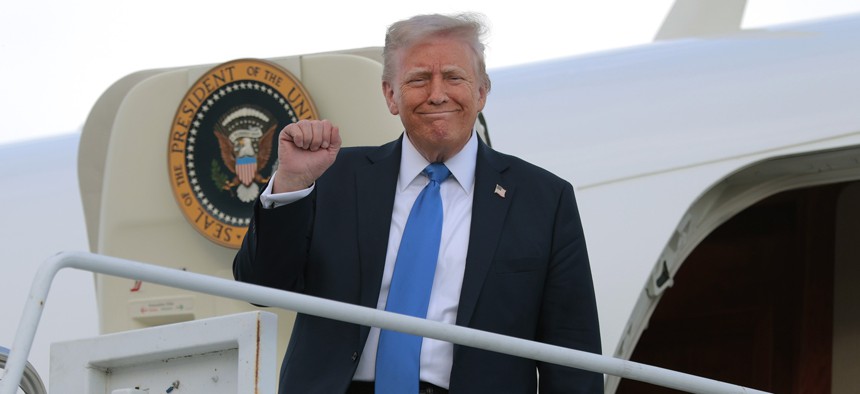
President Donald Trump disembarks from Air Force One at Tuscaloosa National Airport on May 1, 2025 in Tuscaloosa, Alabama. Trump released his "skinny" budget proposal May 2 with sweeping cuts to civilian agencies. Anna Moneymaker/Getty Images
Here are the tech takeaways from Trump’s budget proposal
The White House has suggested sweeping reductions to many civilian agencies, though it promises to maintain investments in emerging technologies.
The Trump administration released the outline of its 2026 budget request Friday morning, calling for a reduction in non-defense discretionary funding by $163 billion, or about 23% from 2025.
The so-called “skinny budget” includes cuts to a range of nondefense discretionary spending — which doesn’t include mandatory programs like Social Security — and increases in some places like the Department of Homeland Security and Federal Aviation Administration. The administration says that it is proposing a 13% increase in defense spending. Some of the increases for defense and border security would come from a reconciliation package the administration is working on with congressional Republicans.
The White House says that it’s taking aim at “woke” diversity programs and work on climate change; moving some government work to the state and local level; and ridding the government of “weaponized rot,” pointing to cuts to the IRS and the Cybersecurity and Infrastructure Security Agency as examples.
The administration wants to cut disinformation offices and programs out of CISA, calling them “a hub in the Censorship Industrial Complex, conspiring against the First Amendment rights of President Trump and his supporters.”
CISA’s budget overall would see a $491 million cut from fiscal 2025 as the administration aims to reshape it amid accusations that its efforts to counter false information on social media censor conservative viewpoints. Disinformation efforts have only been only a sliver of its budget.
In another clash with the previous White House’s priorities, the administration is also proposing a $325 million decrease for the National Institute of Standards and Technology, the Commerce Department’s lab arm, saying that it’s “long funded awards for the development of curricula that advance a radical climate agenda.”
That said, the Trump administration notes that it is maintaining investments in emerging technologies, focusing on funding for artificial intelligence, quantum information science and technology projects.
The White House says that current levels of funding for AI and QIST — and associated disciplines like high performance computing, fusion energy and critical minerals research — will also keep their prior fiscal 2025 funding levels.
“The Budget maintains funding for research in artificial intelligence and quantum information science at key agencies, to ensure the United States remains on the cutting edge of these critical technologies’ development and responsible use,” the summary budget request reads.
For example, the administration celebrated the deployment of new AI solutions at the Social Security Administration. These investments will focus on leveraging AI to “increase employee productivity and automate routine workloads” as a broader effort to ensure timely public service delivery, the summary budget states.
SSA previously rolled out a new generative AI chatbot last month, but experts have cautioned that staffing cuts could push the agency to rely on AI before it's adequately tested or evaluated. The chatbot wasn’t trained on any SSA-specific data.
The FY26 budget will also reroute funding for the Department of Energy to the development of technologies geared towards domestic fossil fuel energy and critical mineral production, in addition to advancing development of nuclear fuels and nuclear reactors. This redirection comes from the cancellation of government funding towards the Biden era Infrastructure Investment and Jobs Act, though a judge has ordered that the Trump administration reinstate that funding.
In terms of how this administration plans to modernize government tech systems, the budget offers a few hints.
The troubled Electronic Health Record Modernization at the Department of Veterans Affairs gets a callout in the budget document for an approximately $2.2 billion boost. The VA would see a $493 million cut to its IT systems, however, and a pause on procurement while billionaire Elon Musk’s Department of Government Efficiency conducts a “full review,” the budget says.
NASA’s information technology services are also called out to be “streamline[d],” alongside its workforce.
The budget incorporates “many of the changes that have been identified from DOGE,” an OMB official told reporters Friday. “We’re joined at the hip with DOGE.”
Democrats on Capitol Hill have already panned the proposal.
“This preliminary budget proposal is exceptionally light on details we desperately need—but this much is clear: Trump wants to eviscerate programs that matter most to working families,” Sen. Patty Murray, D-Wash., said in a statement, promising to “firmly reject” the proposal and asking for Republicans to join Democrats in reacting to the Trump administration’s withholding of congressional funding, something that the Government Accountability Office is reviewing due to potential violations of the Impoundment Control Act.






